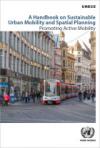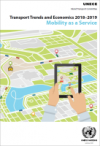Publications
Displaying Results 41 - 60 of 207
- English
While the second half of 2020 was marked by the warranted fight against the COVID-19 pandemic which continued to change the face of the world, our ambitions for a better global road safety were not scaled back. COVID-19 has taught us to move away from the “silo mentality” and instead align development goals with each other - resulting in higher impact policies and programs.
- English
The UN Road Safety Fund was established in 2018 as a UN multi-partner trust fund pursuant to the General Assembly resolution 70/260 and with the support of the UN Secretary-General. It aims to help low- and middle-income countries put in place an effective national Safety System to substantially
- English
Updated Guidelines on the use of the UNRSF brand and logo
- Pусский
Цель общеевропейских рекомендаций, применимых к судам внутреннего плавания, – установление согласованного режима технических требований к судам, участвующим в международных перевозках грузов и пассажиров. Они являются результатом усилий правительств, направленных на унификацию отличающихся друг от друга правил, действующих в различных международных организациях и в странах-членах ЕЭК ООН.
- Français
Les recommandations paneuropéennes pour les bateaux de navigation intérieure visent à établir un régime harmonisé de prescriptions techniques pour les bateaux qui transportent des marchandises et des passagers au niveau international. Ces recommandations sont le résultat des efforts déployés par les gouvernements pour unifier les réglementations divergentes en vigueur dans les différentes
- English
The pan-European recommendations for inland navigation vessels aim to establish a harmonized regime of technical requirements for vessels that transport goods and passengers internationally. The recommendations are the result of Government efforts to unify divergent regulations in force in different intergovernmental organizations and ECE member countries.
The recommendations were first adopted
- Pусский
В 2002 году государства-члены Европейского региона ЕЭК и ВОЗ разработали Общеевропейскую программу по транспорту, окружающей среде и охране здоровья (ОПТОСОЗ). ОПТОСОЗ обеспечивает межсекторальные и межправительственные политические механизмы, что способствует развитию мобильности и транспортных стратегий, которые учитывают проблемы окружающей среды и здоровья. За все эти годы в рамках ОПТОСОЗ
- English
Member States in the ECE and WHO European Region established the Transport,Health and Environment Pan European Programme (THE PEP) in 2002. By providing an intersectoral and intergovernmental policy framework, THE PEP promotes mobility and transport strategies that integrate environmental and health concerns. Over the years, THE PEP has led to the development of implementation mechanisms to
- English
The UNRSF launches the second issue of its newsletter at a time when the world continues to face unprecedented change and disruptions due to the Covid-19 pandemic. However, the momentum gained with the 3rd Global Ministerial Conference on Road Safety in February 2020 where the Stockholm Declaration was launched with an ambitious target to reduce road deaths and injuries by 50% by 2030 must not
- English
The UN Road Safety Fund’s (UNRSF) secretariat seeks additional financial support from private and public sector donors where the Fund’s mission and donor priorities are aligned. Read more in the UNRSF donor brochure to consider becoming a donor.
Contact the UNRSF secretariat for more information at unrsf_secretariat
- Français
Il existe 59 instruments juridiques onusiens dans le domaine des transports intérieurs qui sont administrés par le Comité des Transports Intérieurs de la Commission Economique des Nations Unies pour l'Europe (CEE-ONU). Parmi les 59 conventions, sept instruments dans le domaine de la sécurité routière sont considérés comme des priorités pour l’adhésion:- 1968 Convention sur la circulation
- Español
Existen 59 instrumentos jurídicos de las Naciones Unidas en el ámbito del transporte terrestre que son administrados por la Comisión Económica de las Naciones Unidas para Europa (CEPE). De las 59 convenciones, siete instrumentos se consideran prioritarios en seguridad vial para la adhesión:- Convención de 1968 sobre la circulación vial;- Convención de 1968 sobre la señalización vial;- Acuerdo
- English
There are 59 United Nations legal instruments in the area of inland transport which are administered by the United Nations Economic Commission for Europe (UNECE). Of the 59 conventions, seven road safety instruments are considered to be priorities for accession:
- 1968 Convention on Road Traffic;
- 1968 Convention on Road Signs and Signals;
- 1958 Agreement concerning the Adoption of
- English
The UNRSF 2019 Annual Report is now available. Established two years ago as an innovative United Nations pooled fund, the Annual Report showcases the first concrete results of the UNRSF and thus demonstrates its potential to meet its ambition to substantially reduce death and injuries from road crashes in low and middle-income countries where 93% of the world fatalities occur.
- English
Organizations around the world are quickly adapting their programme and project activities to respond to the COVID-19 pandemic and its consequences. The UN Road Safety Fund is committed to the principles of adaptive programming, partnerships, and relevance. The operationalization of these principles is even more critical during this unparalleled time. This flyer provides tools and tips for
- English
This publication provides comparable data on road traffic accidents in Europe, Canada and the United States. Data are organized by the nature of accident, and the number of persons killed or injured, by category or road user, age group and sex. As background data, figures on the number of road vehicles in use and vehicle-kilometers run by road vehicles are also provided along with estimates of
- English
The April 2020 marks the second anniversary of the launch of the United Nations Road Safety Fund (UNRSF). The Fund is now financing 15 projects in 20 low- and middle-income countries to substantially reduce death and injuries from road crashes and to reduce economic losses resulting from these crashes.
- English
As part of the ongoing work on THE PEP a Study on good practices in Mobility Management has been published.Drawing on concrete experiences from across the Pan-European region, the guide, developed under the Transport Health and Environment Pan-European Programme (THE PEP), provides practical policy considerations enriched by a total of 22 good practices from 17 countries that set out the
- English
Mobility as a Service (MaaS) is a new mobility concept gaining pace in many cities around the world. Its value proposition concerns integration of mobility services which is realized by providing trip planning and one-stop fare purchase for the user through a single platform.Since MaaS is only emerging, the analysis of real-life demonstrations is still limited and, thus, evidence on the
- English
Regional maps available here
Extreme weather events, some of which are increasing in intensity and frequency, as well as slower onset climate changes (for example, sea level rise) and cumulative effects can result in transportation infrastructure damages, operational disruptions, and
















